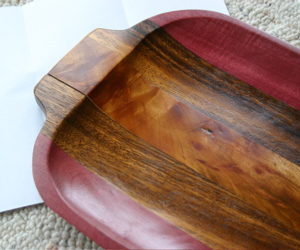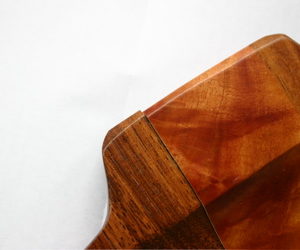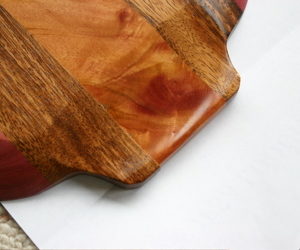A friend recently returned from Central America. His wife haf purchased a “plate” constructed of exotic woods. (At least they don’t look like any of our species.) There was a crack in one end and I was asked to fix it. (As a favor, no risk involved for me – “it’s no good as it is anyway.”)
I am amazed at the longitudinal displacement between strips 3 and 4; there is a slight vertical displacement. I suspect that the grain near the end of the center stip changed from “long grain” to “cross grain” which accounted from the differential shrinkage.
I intend to tape the top of the plate (to prevent seep-though leakage) and apply CA (the thin stuff) to the crack on the bottom, while I use a spring clamp to even the vertical displacement. I don’t see anything I can do about the longtudinal displacement – and in fact don’t think that any repair can last.
Comments?
Jerry


















Replies
It looks like the lumber used had very different moisture contents when glued up. I can't imagine that much movement in wood that had beed dried suffeciently.
Mike
Hi Jerry ,
Besides the different grain patterns possibly contributing to the movement , my guess is the RH factor has changed considerably from the plates origin to it's new home .
Depending on how recently this plate has been here , I would wait a while longer to see if it is done moving , shrinking and growing .
I would try to fill the void with a thin sliver or wedge strip of wood that matches the material the best , then reshape the edge .
best of luck dusty
Could you not continue the split on the join line and then re-joint the bowl? Otherwise your work may be for naught.
You could very well have several reasons for this split, the most obvious of which is moisture content. Some of the exotics are oily and require nuanced gluing. If it were me, and the joint won't break cleanly for rejointing, i would use epoxy or a polyurethane to fill the crack. You can color it to make it look like a part of the stripey wood, which looks like it might be bocote, one of the woods that is tricky to glue. It's only a band-aid, but if the wood isn't kiln-dried, you may be in for a lot more gluing still.
I made a living laminating and found i couldn't use any but kiln-dried wood or i had an unacceptable amount of seasonal movement.
Hi Jerry,
Were I to tackle this job, I'd probably measure the moisture content of each species every so often and make sure the piece had reached equilibrium moisture content before making repairs. Or I might put it in a lightbulb kiln, weighing it every few days until the weight stopped changing.
I'd probably band saw the piece along the failing joint, use a sharp hand plane to re-joint both boards, and re-glue. A little carving and sanding would probably be necessary to smooth the contours after the glue cured.
That being said, if the adjacent species have markedly different rates of expansion and contraction, the wood will continue to migrate relative to one another; using white or yellow glue will allow this kind of movement to continue, while a urea formaldehyde formulation like Unibond-800, or epoxy, won't creep as much as aliphatic resin adhesives.
If you decide to use CA, you might want to try using a vacuum cleaner to draw it into the crack.
Good luck,
-Jazzdogg-
"Don't ask yourself what the world needs. Ask yourself what makes you come alive, and go do that, because what the world needs is people who have come alive." Gil Bailie
Thanks for the good suggestions. As I see it, since I leave on Saturday for three weeks, I had two options: CA it now and see how it looks and how it holds up; go radical, cut it apart, tru the pieces and reglue.I chose the CA approach. The wood appears very oily - but the CA seems to hold. I'm not too pleased with the look(the glue joint shows somewhat) and have told my friend if he is not happy, to contact me on my return and I'll try the other approach. I'd probably go with epoxy then because of the oilyiness. (Is that a word?) My problem then is how to control any squeeeze-out.Thanks for the help and support.Jerry
You might try epoxy mixed with sawdust from walnut or another species that is similar in color to that native wood. The sawdust will thicken the epoxy so that it is less runny and easier to control. Many times I will use a clear packing tape on the bottom side of the joint to contain and closely shape the epoxy/sawdust repair. Once a coat of finish has been applied the repair will almost blend inconspicously. Good luck.
Many thanks for the suggestion.Sorry for the late reply - I've been away for two weeks.Jerry
This forum post is now archived. Commenting has been disabled